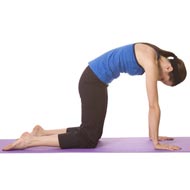Kripalu Yoga Definition, Trainer and Practice to Lose Weight
What is kripalu yoga?
Kripalu yoga is a fairly new and gentle form of Hatha yoga, which involves the highest amount of inward focus, as compared to other popular types of yoga.
Individuals who practice Kripalu yoga generally talk about “Prana”, which is interpreted as a “Life Force” by some and “Pulse” by others.
According to the practitioners and proponent of this yoga discipline, Kripalu Yoga focuses on a type of body, mind & energy paradigm. While mainstream & traditional yoga have a few specific purposes for centering the mind and body as well as meditative stability, Kripalu Yoga takes this a few steps further.
Kripalu Yoga is often described as an inquiry-based form of yoga, which promotes active thinking at all times, whether you are on or off the yoga mat. This discipline fosters specific types of self-awareness that exist during and between yoga sessions, though their forms may be different. Those who are familiar with the practice claim that Kripalu yoga is a tool for personal development and self-empowerment, as it teaches you to tap into your inner knowledge, instead of depending upon guidance from others. This practice teaches you to be open to what others are offering, without relinquishing your power to reason, categorize and take your own decisions. At the same time, this practice is also supposed to help you in establishing a nurturing and intimate relationship with your body. You will treat each of your sensations as sacred and respond to them with compassion and tenderness.
While practicing Kripalu Yoga, you will be encouraged to approach each session with an attitude of prayer, where your body becomes a temple through which you can implore the presence of the divine. Given below are the 3 stages of Kripalu Yoga –
Stage 1: Willful Practice
In this stage, you need to pay exact attention to the details and alignment of each posture. You’ll also learn about breathing deeply, coordinating your breath with movement.
The different aspects of this stage include –
- Asana (posture)
- Press points
- Willful versus forceful
- Self-acceptance
- Pranayama (Control of Breath and Life Force)
Stage 2: Will and Surrender
In this stage, you will need to continue integrating the guidelines of the first stage, but prolong the holding of each posture. Some of the aspects of this stage include –
- Pratyahara (Internalizing your outgoing energy)
- Dharna (Concentration)
- Working with fear and pain
- Releasing the posture
- Spontaneous movement
Stage 3: Surrender to the Wisdom of the Body
After completing the first 2 stages of kripalu yoga, you move to the final expression or the third stage, in which you need to, put aside all the rules and restrictions you’ve been practicing. The important aspects of this stage include –
- The wisdom of Prana
- Dhyana (Meditation)
- Samadhi (Absorption)
With this intention, you can reach new depths in your life, as well as your practice of this discipline.
2. Kripalu yoga poses
Most of the poses of Kripalu yoga are quite easy to perform, even by those who are new to the practice or are not very physically fit. This discipline focuses on the importance of listening to the body and doing what feels right, not just during your practice, but also in your daily life.
There are several different yoga postures that are included in Kripalu Yoga. Some of the common kripalu yoga poses include –
- Ado Mukha Savasana (The Downward Facing Dog Pose)
- Ardha Chandrasana (The Half Moon Pose)
- Ardha Salabhasana (The Half Locust Pose)
- Ardha Sarvangasana (The Half Shoulder Stand)
- Balasana (The Child Pose)
- Bhujangasana (The Cobra Pose)
- Dhanurasana (The Bow Pose)
- Garudasana (The Eagle Pose)
- Janu Sirasana I and II (The Standing Head To Knee Pose I and II)
- Kapotsana I and II (The Pigeon Pose I and II)
- Mandukasana (The Frog Pose)
- Matsyasana (The Fish Pose)
- Navasana (The Boat Pose)
- Padahastasana (The Standing Hand To Foot Pose)
- Paschimottasana (The Seated Forward Bend Pose)
- Salabhasana (The Locust Pose)
- Setu Bandhasana (The Bridge Pose)
- Tadasana (The Mountain Pose)
- Trikonasana (The Triangle Pose)
- Upavistha Konasana (The Seated Angle Pose)
- Urdhva Mukha Savanasana (The Upward Facing Dog Pose)
- Ustrasana (The Camel Pose)
- Utkatasana (The Chair Pose)
- Virasana (The Hero Pose)
- Virbhadrasana I and II (The Warrior Pose I and II)
- Vrikshasana (The Tree Pose)
Before practicing any of these Kripalu Yoga postures, it is absolutely essential to check with a doctor. This is all the more important if you are elderly or are suffering from any preexisting medical condition.
3. Kripalu yoga benefits
According to the New York Center for Kriplau Yoga and Health, the main benefit of this yoga form is release of Prana, or the life force throughout the body, to get rid of tensions. Some of the other kripalu yoga benefits include –
- Alleviating mental and emotional problems like depression, anxiety and hyperactivity
- Better posture alignment
- Boost in strength, endurance, stamina and flexibility
- Higher awareness of the body
- Improving circulation and the distribution of oxygen within the body
- Increase in confidence and energy levels
- Reducing unproductive thinking
- Relaxation and improved sleeping patterns
Though there are several health benefits associated with Kripalu Yoga, it is important to check with a doctor before practicing it.



